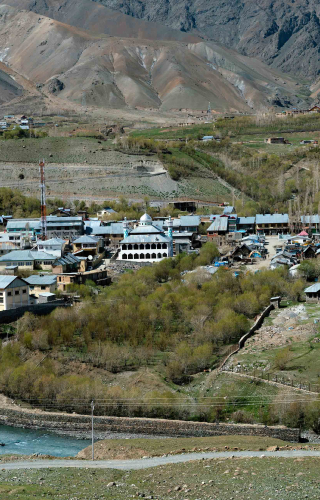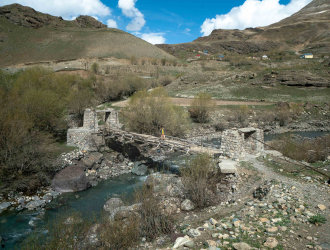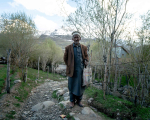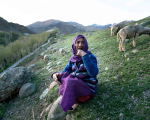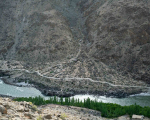The Partition of the Indian subcontinent in August 1947 led to the largest ever migration in human history and many ethnic groups and communities found themselves scattered across the borders of India, Pakistan and Bangladesh. As Independence neared, India and Pakistan both lay claim on Kashmir which till then was a princely state ruled by a Hindu Dogra king. The last Maharaja of Kashmir, Hari Singh, acceded his state to India in October 1947, but war broke out immediately. Pakistani troops moved first and from June to November 1948, Kargil and Dras were occupied by the Gilgit Scouts. The Indian Army was airlifted in Kashmir Valley; they successfully pushed back the intruders 12 km from Dras before a United Nations-backed ceasefire was called in 1949. Further wars followed in 1965 and 1971 and territorial demarcations kept changing, hugely impacting the people living in the border areas. The ceasefire line was accepted as the Line of Control after the 1972 Shimla Agreement, and India retained Kashmir, Jammu, Ladakh, Kargil and Zanskar.
Prior to the 1971 war, many border villages, which are now part of India, were under Pakistan. The residents of the villages in the newly acquired lands became Indian overnight after the war. One of the many ethnic groups which were separated due to the changing geopolitics of the region were the Baltis. I first heard about the Baltis on a visit to Dras, a stopover town on the road from Srinagar to Leh. With the help of my guide Nazir, I met a Balti activist and teacher, Zakhir Khan, who promised to show me Balti villages around Dras—namely, Goshan, Moradbad and Bhimbat. Gilgit-Baltistan is the original homeland of the Baltis, but the population is also scattered in neighbouring regions due to a long history of trading and inter-marriage. As per historical records, the Balti king of Skardu, Ali Sher Khan Anchan, conquered Ladakh and married a Mughal princess named Gul Khatoon. Dras and Kargil were gifted as dowry to Anchan as part of a peace treaty. His conquest of this region introduced the Balti language and culture to Kargil and Dras. The practice of exchanging princesses in marriages for political convenience was a prevalent feature of ancient diplomacy. Many princesses from the Balti region married into the Ladakhi royal family and vice-versa.
Baltistan is strategically located at the crossroads of Kashmir, Ladakh, Afghanistan, Punjab, Xinjiang, parts of Central Asia, Tibet and Swat. Naturally, Baltis living in Kargil and Dras were heavily involved in trade and the region was once an important stop on the Silk Route connecting Srinagar to Gilgit in the north and Leh in the east. Baltis are famed as efficient horsemen and hardy porters which led to them being recruited as guides and porters by Central Asian traders and, later on, by European surveyors of the Himalayas.
Things changed dramatically with the departure of the British from the subcontinent, leaving the fate of the Baltis in the hands of two hostile neighbouring countries. Every time India and Pakistan went to war, Baltis felt the heat due the proximity of their villages to the India-Pakistan border. War constantly looms over daily life in this region, and it has significantly altered the socio-cultural fabric and regional economics—bringing an end to old trade routes and long-established family ties of nomadic and pastoral communities living in the region. Added to the hardship of separation and loss of trade is the remote and hostile environment of the high Himalayas. Dras and Kargil are among the coldest permanently inhabited places on the planet. Snowfall in winter goes 16-feet deep and the temperature drops to -60 degree Celsius.
Not to be deterred by the burden of history and geography, the Baltis have shown great resolve in trying to reconnect with their roots. In Kargil, I met Sadiq Hardassi, a Balti activist and author who has been working on uniting ‘divided families’. He visited Pakistan in 2012 to meet his own relatives who were separated during Partition. He is also an active member of the group ‘Hum fir kab milenge?’ where scholars from both India and Pakistan are running a campaign to discuss the possibilities of reuniting families. He mentions, ‘Earlier people were afraid to even speak about having a relative in Pakistan, but slowly they are recognising their rights and making efforts to connect with them through Facebook and Whatsapp which has proved to be a boon for them.’
Similarly, Ansari, one of the inhabitants of Hundarman village, has converted his ancestral home into a museum. Here he has created a ‘museum of memories’ to document what they have been through all these years. Poignant photos of identification cards in the museum reflect the reality of living in border villages where privacy and dignity of individuals are readily sacrificed in the larger interest of securing the porous borders from infiltration by the enemy.
Also struggling for recognition and continuity is the Balti language. Heavily influenced by loan words from other languages, Balti language lacks popularity. Despite the efforts of activists, Balti hasn’t been registered as an official language or encouraged to be spoken/learnt in schools. In my interactions with the locals, I heard many folk tales which are untraceable on the internet. A few things, I suppose, will just pass on from generation to generation verbally, surviving as oral history.
We don’t often get to hear stories from the border regions and the long-term impact Partition had on local populations. Spending time in Dras and Kargil was an eye-opening experience for me. Through this photo essay, I have tried to provide insights on the various aspects of life and culture in the Balti villages. However, I feel I have only scratched the surface and I need to go back to dig deeper. Like the Baltis, there are many more ethnic groups who are struggling to safeguard their identity, culture and heritage.
Mohammad Hasan Hasti, a poet from Skardu, Gilgit-Baltistan, sums up this feeling of separation when he writes in one of his poems:
Ek deewar ki doori hain milne mein, ae qafas.
Yeh deewar na hoti toh hum chaman mein hote.
Oh dear (the one in a cage); there is a distance of only a wall between.
If there wasn’t any wall (border), we would have been in paradise (undivided India)
